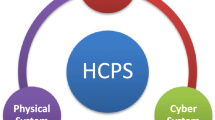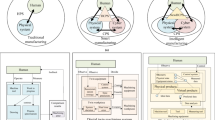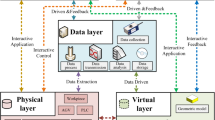Abstract
Digital Twin (DT) machining technology enables real-time monitoring of machining operations, ensuring precision in the process. The virtual–real separation display method utilizes advanced DT systems, but it hinders the effective transmission of essential data to local technicians, thereby limiting the utilization of field processing supported by DT systems. Augmented Reality (AR) is employed to address the issue of monitoring the machining process, which is facilitated by a DT system. First, a dynamic multi-view for AR is created by incorporating data from various sources. Second, ongoing observation of the intermediate processing in AR promotes collaboration between the DT machining system and operators, particularly for complex products, preventing irreparable errors when the final product is nearly complete. The framework includes a module for data representation and detailed explanations are provided for the modules focused on data management and data organization. In a case study, the application of cutting tool wear prediction demonstrates the feasibility and the effectiveness of the proposed method for data construction.







Similar content being viewed by others
References
Hasan SM, Lee K, Moon D, Kwon S, **woo S, Lee S. AR and DT system for interaction with construction machinery. J Asian Archit Build Eng. 2022;21(2):564–74.
Alizadehsalehi S, Yitmen I. DT-based progress monitoring management model through reality capture to extended reality technologies (DRX). Smart Sustain Built Environ. 2021. https://doi.org/10.1108/SASBE-01-2021-0016.
Lyons N. Deep learning-based computer vision algorithms, immersive analytics, simulation software, and virtual reality modeling tools in DT-driven smart manufacturing. Econ Manag Financ Mark. 2022;17(2):67–81.
BaghalzadehShishehgarkhaneh M, Keivani A, Moehler RC, Jelodari N, RoshdiLaleh S. Internet of things (IoT), building information modeling (BIM), and DT (DT) in construction industry: a review, bibliometric, and network analysis. Buildings. 2022;12(10):1503.
Ramos-Hurtado J, Muñoz-La Rivera F, Mora-Serrano J, Deraemaeker A, Valero I. Proposal for the deployment of an AR tool for construction safety inspection. Buildings. 2022;12(4):500.
Umamageswari A, Bharathiraja N, Shiny Irene D. A novel fuzzy C-means based chameleon swarm algorithm for segmentation and progressive neural architecture search for plant disease classification. ICT Express. 2021. https://doi.org/10.1016/j.icte.2021.08.019.
Feng H, Chen Q, de Soto BG. Application of DT technologies in construction: an overview of opportunities and challenges. In: ISARC. Proceedings of the international symposium on automation and robotics in construction, IAARC Publications; 2021. vol. 38. pp. 979–986
Kolaei AZ, Hedayati E, Khanzadi M, Amiri GG. Challenges and opportunities of AR during the construction phase. Autom Constr. 2022;143: 104586.
Latchoumi TP, Swathi R, Vidyasri P, Balamurugan K. Develop new algorithm to improve the safety Of WMSN in health disease monitoring. In: 2022 International mobile and embedded technology conference (MECON). IEEE; 2022. p. 357–362
Aivaliotis S, Lotsaris K, Gkournelos C, Fourtakas N, Koukas S, Kousi N, Makris S. An AR software suite enabling seamless human-robot interaction. Int J Comput Integr Manuf. 2022;36:1–27.
Opoku DGJ, Perera S, Osei-Kyei R, Rashidi M, Famakinwa T, Bamdad K. Drivers for DT adoption in the construction industry: a systematic literature review. Buildings. 2022;12(2):113.
Lin C, Hu ZZ, Yang C, Deng YC, Zheng W, Lin JR. Maturity assessment of intelligent construction management. Buildings. 2022;12(10):1742.
Kikuchi N, Fukuda T, Yabuki N. Future landscape visualization using a city DT: integration of AR and drones with the implementation of 3D model-based occlusion handling. J Comput Des Eng. 2022;9(2):837–56.
Yi L, Glatt M, Ehmsen S, Duan W, Aurich JC. Process monitoring of the economic and environmental performance of a material extrusion printer using an AR-based DT. Addit Manuf. 2021;48: 102388.
Sneha P, Balamurugan K. Investigation on wear characteristics of a PLA-14% bronze composite filament. In: Recent trends in product design and intelligent manufacturing systems. Singapore: Springer; 2023. p. 453–61.
Tao F, **ao B, Qi Q, Cheng J, Ji P. DT modeling. J Manuf Syst. 2022;64:372–89.
**n F, Wang H, Liu G, Tian X, Ding G, Zhang H. Industry application of DT: from concept to implementation. Int J Adv Manuf Technol. 2022;121:1–24.
Latchoumi TP, Ezhilarasi TP, Balamurugan K. Bio-inspired weighed quantum particle swarm optimization and smooth support vector machine ensembles for identification of abnormalities in medical data. SN Appl Sci. 2019;1:1137. https://doi.org/10.1007/s42452-019-1179-8.
He F, Ong SK, Nee AY. An integrated mobile AR DT monitoring system. Computers. 2021;10(8):99.
Liu S, Sun Y, Zheng P, Lu Y, Bao J. Establishing a reliable mechanism model of the DT machining system: an adaptive evaluation network approach. J Manuf Syst. 2022;62:390–401.
Ssin S, Suh M, Lee J, Jung T, Woo W. Science tour and business model using DT-based AR. In: AR and virtual reality. Cham: Springer; 2021. p. 267–76.
Anand M, Balaji N, Bharathiraja N, Antonidoss A. A controlled framework for reliable multicast routing protocol in mobile ad hoc network. Mater Today Proc. 2021. https://doi.org/10.1016/j.matpr.2020.10.902.
Opoku DGJ, Perera S, Osei-Kyei R, Rashidi M. DT application in the construction industry: a literature review. J Build Eng. 2021;40:102726.
Ozturk GB. DT research in the AECO-FM industry. J Build Eng. 2021;40:102730.
Garikapati P, Balamurugan K, Latchoumi TP, Malkapuram R. A cluster-profile comparative study on machining AlSi 7/63% of SiC hybrid composite using agglomerative hierarchical clustering and K-means. SILICON. 2021;13:961–72.
Rauscher F, Fischer G, Lehmann T, Zapata JJ, Pagani P, Loving A. A DT concept for the development of a DEMO maintenance logistics modeling tool. Fusion Eng Des. 2021;168: 112399.
Zhang Y, Zhang C, Yan J, Yang C, Liu Z. The rapid construction method of equipment model for discrete manufacturing DT workshop system. Robot Comput Integr Manuf. 2022;75: 102309.
Liu J, Liu J, Zhuang C, Liu Z, Miao T. The construction method of the shop-floor DT is based on MBSE. J Manuf Syst. 2021;60:93–118.
Funding
The authors declare that no funding has been received to carry out the work.
Author information
Authors and Affiliations
Corresponding author
Ethics declarations
Conflict of interest
The authors declare that they have no conflict of interest.
Additional information
Publisher's Note
Springer Nature remains neutral with regard to jurisdictional claims in published maps and institutional affiliations.
This article is part of the topical collection “Research Trends in Communication and Network Technologies” guest edited by Anshul Verma, Pradeepika Verma and Kiran Kumar Pattanaik.
Rights and permissions
Springer Nature or its licensor (e.g. a society or other partner) holds exclusive rights to this article under a publishing agreement with the author(s) or other rightsholder(s); author self-archiving of the accepted manuscript version of this article is solely governed by the terms of such publishing agreement and applicable law.
About this article
Cite this article
Sahoo, S.K., Nalinipriya, G., Srinivasan, P.S. et al. Development of a Virtual Reality Model Using Digital Twin for Real-Time Data Analysis. SN COMPUT. SCI. 4, 549 (2023). https://doi.org/10.1007/s42979-023-01928-5
Received:
Accepted:
Published:
DOI: https://doi.org/10.1007/s42979-023-01928-5




